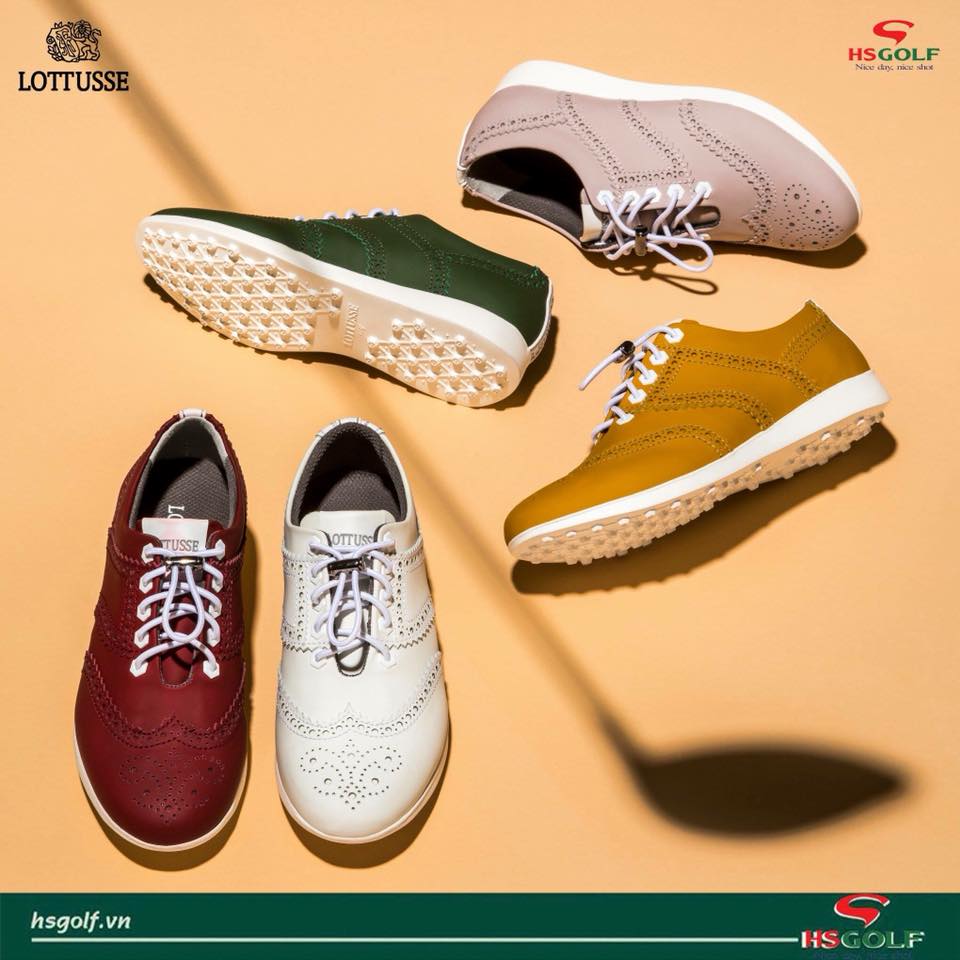Vietnam! Inside the world’s next great golf destination
Views: 4623
- Việt Nam nominated in the best golf courses list of the world
- ‘Vietnam’s Rising Stars’ Golf Match Presented by Greg Norman
- VGA and EPGA to promote golf among youngsters
- Chang Hsin-chiao victory at Faldo Series Asia Grand Final
In another setting, an SUV emblazoned with giant flaming golf balls might not cause a stir. But on the honeycombed streets of Hanoi, swarmed by motorbikes and rickshaws, and shadowed by ornate imperial pagodas, it stands out like a pushcart at a NASCAR race.
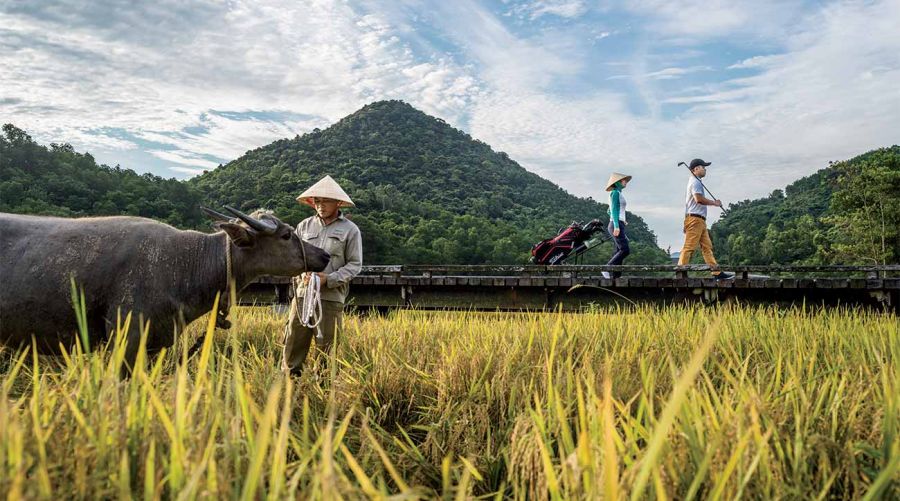 On Laguna Lăng Cô, Sir Nick’s second design in Vietnam, it is absolutely best to avoid the rough. I Christopher Wise
On Laguna Lăng Cô, Sir Nick’s second design in Vietnam, it is absolutely best to avoid the rough. I Christopher Wise
Perched at the wheel of his Toyota Fortuna, Duc Pham navigates the morning frenzy, rounding a rotary and ripping through an intersection without slowing, red lights in this city being mostly just for show. A traffic cop, his head on a swivel, tracks Pham’s ride as it passes. A cluster of school children, crowded on a corner, flash thumbs up and shout in Vietnamese. “They’re basically saying, ‘Hey, that’s cool, man!’ ” Pham explains, translating their reaction to his car’s airbrushed side panels. “But I’m not sure they know what a golf ball is.”
When he was their age, Pham, now 31, didn’t have a clue. That was in the early ’90s, and golf around Hanoi wasn’t even yet a novelty; it was nonexistent. Pham’s chosen sports were two national favorites: soccer and da cau, a variant of badminton played with one’s feet.
In 1997, though, a game with a broad and deepening grip elsewhere in Asia finally got a foothold in Pham’s part of the world. It happened with the opening of Kings Island, on a lake-wrapped peninsula 30 miles west of the capital, Hanoi. It was the first golf course in northern Vietnam. Pham’s father, a government official, got invited to an outing, and he brought along his then 11-year-old son. “I remember my first practice shot going high and straight, and the guys there telling my father, ‘Your boy is a natural!’ ” Pham says. “I was really proud.”
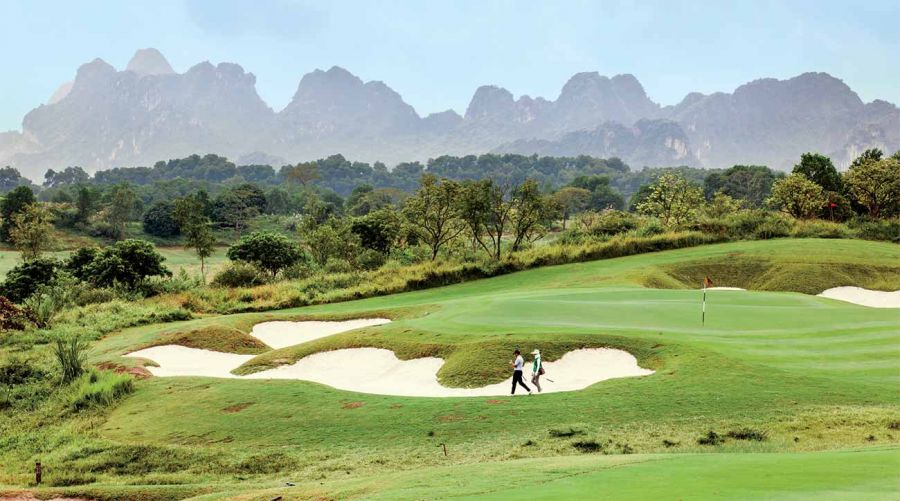 The Lake Course at Sky Lake Resort in Hanoi, opened in 2012, has ample greenery—and teeth I Christopher Wise
The Lake Course at Sky Lake Resort in Hanoi, opened in 2012, has ample greenery—and teeth I Christopher Wise
After high school, Pham, an unreformed golf junkie in a region with few outlets to indulge his fix, embarked for Brisbane, Australia, the better to immerse himself in the game. He returned home eight years later, armed with impeccable Aussie-inflected English and membership in the PGA of Australia, making him the first—and still the only—Vietnamese citizen to earn those stripes. In the years since, having parlayed his credentials into two successful golf academies and retail shops in Hanoi, as well as his own golf instruction show on Vietnamese TV, Pham has emerged as a leading figure in a fast-growing market and as something of an emblem of today’s Vietnam—a communist country where capitalism is alive and well. As is its favorite leisure sport.
Over the past decade, in the distant wake of golf’s arrival in Japan and its more recent wildfire spread in Korea and China, a burgeoning monied class has given rise to a swelling population of Vietnamese golfers and triggered a starburst of course construction. Layouts by the marquee likes of Greg Norman and Jack Nicklaus now stretch from Ho Chi Minh City (formerly Saigon) in the south to Vietnam’s northern border with China, where noted architect Brian Curley has carved a stunner that overlooks the postcard-worthy rock outcrops of Ha Long Bay.

Duc Pham, Vietnam’s only PGA professional, likes his ride—and his roadside cuisine—extra spicy. Christopher Wise
Across the country, locales whose names might resonate for other reasons have been transformed into busy redoubts for the game. In the village of Lăng Cô, near the Hai Van Pass, site of some of the fiercest fighting of the Vietnam War, a cool Nick Faldo course—an amenity for two luxury hotels—now spreads between the mountains and the sea, its rice-paddy hazards grazed by water buffalo. In and around Da Nang, once a central base of American military operations, R&R today includes the option of a round at one of four courses, among them designs by Norman, Nicklaus and Colin Montgomerie, whose layout, Montgomerie Links, is dotted at its edge by a weathered machine-gun pillbox. A fifth nearby course, slated to open this summer, also winds around a wartime relic—a concrete bunker. But the most distinctive traits of Robert Trent Jones Jr.’s layout-in-the-making are the artful rumples of a first-rate seaside track.
“Setting foot on it is a bit of a time warp,” Jones Jr. says. “The land has a rich history, which we’ve aimed to preserve. It also happens to be ideal for golf.”
Vietnam has a bounty of such sites, thanks in no small part to a sandy shoreline that extends for more miles than the entire West Coast of the United States. That factor alone gives Vietnam an edge in the race toward the golf future over such space-pinched countries as South Korea and Japan. Balmy year-round temperatures are also an advantage. The political climate is accommodating, too. In contrast to China, where the government’s anti-corruption campaign has put the kibosh on new course construction, Vietnam’s ruling party has proclaimed its goal of pumping up supply. A plan put forth by the prime minister’s office calls for the completion of 89 new courses by 2020, nearly double the number that exist today.
Financial muscle for such projects used to come mostly from overseas, but like so much else in Vietnamese golf, it’s begun to skew domestic. Take the evolution of Kings Island, where Duc Pham first swung a club. The property, which visitors access by driving to a dock an hour west of Hanoi then hopping onto a motorboat across a lake, was originally developed in 1997 by a Thai businessman. Less than two years later, it was snatched up by Nguyen Thi Nga, a feisty sixty-something with close-cropped hair, a taste for floral-patterned dresses and a net worth that reportedly makes her one of the wealthiest women in Vietnam.
As the chairwoman of BRG Group, a conglomerate that deals in banking, real estate and retail chains, among other holdings, Madame Nga is afforded a professional respect that verges on reverence, and her lofty status, in a business culture layered with ritual-like formalities, turns interviews with her into grand affairs, wrapped in the trappings of a United Nations session.

The 15th on architect Brian Curley’s sublime “Course A” track, in Dong Hoi, runs up against the South China Sea—and has the sand to show for it.
Christopher Wise
On this hazy afternoon in the capital, she is camped in a lounge chair in a boardroom of a BRG-owned bank, ringed by an entourage. A videographer films. A stenographer scribbles. An attendant pours tea. Madame Nga wears an earpiece to follow the whispers of a translator who sits only a few feet away. The chairwoman smiles as she speaks, and punctuates her words with elaborate hand gestures.
At the outset, she says, she wasn’t drawn to golf for golf itself. Her introduction to the game came at a corporate event nearly 20 years ago. She didn’t play that day, but two things struck her: the emerald beauty of the landscape, and the preponderance of boardroom bigwigs.
“From my perspective, it was quite clear,” she says. “Golf was a good business opportunity.”
Still, you know the story: a few flushed shots, and a devotee was born. Madame Nga’s fondness for the game has since grown so intense that it’s become the source of a family joke, her children having given her handwritten signs to hang by her bed that read, “Golf is my love. Golf is my life.”
She plays as often as her stacked schedule allows, usually on weekends, frequently on courses that she owns. There is no shortage of them. Soon after purchasing Kings Island, Madame Nga added a second course on the grounds. Just this past year, she cut the ribbon on a third, the Kings Course, a rolling layout that takes ample advantage of its lakeside terrain, building toward a rousing finish and a par-3 19th hole with an island green—a memorable stage for settling bets.
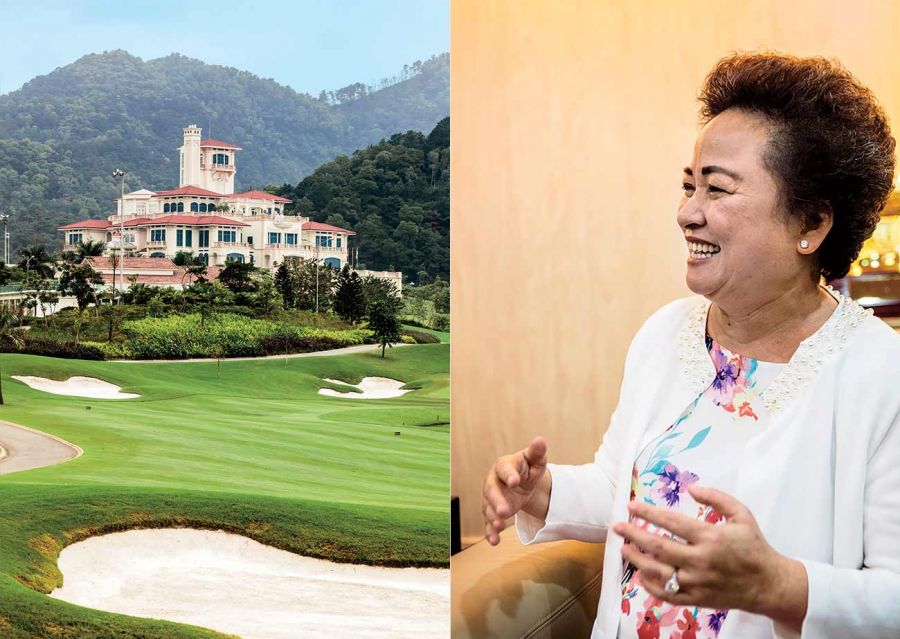 Legend Hill, the first of the Nicklaus-designed courses in Vietnam, features two greens on every hole and is owned by the colorful, commanding BRG chairwoman, Nguyen Thi Nga I Christopher Wise
Legend Hill, the first of the Nicklaus-designed courses in Vietnam, features two greens on every hole and is owned by the colorful, commanding BRG chairwoman, Nguyen Thi Nga I Christopher Wise
Designed by Jack Nicklaus II, the Kings Course is part of a larger deal between BRG and the Nicklaus group that has already yielded three courses around the country and calls for the completion of another five by 2020. At Madame Nga’s insistence, each development boasts a signature feature. At the Kings Course, that role is filled by the island-green 19th. At Legend Hill, another of her Golden Bear–designed Hanoi-area courses, each of the 18 holes has two distinct green complexes, on which play alternates from one day to the next. Such projects result from interplay between architect and owner that can be enlightening for both sides.
“As an architect, I’m always focused first on good golf course strategy,” says Nicklaus II. “But what I’ve learned is that as important as strategy is, Madame [Nga] puts more emphasis on beauty and difficulty. And the truth is that those things aren’t mutually exclusive. I can accomplish good strategy but also make a golf course that’s beautiful and tough.”
* * * * *
During golf’s embryonic stages in Vietnam, course aesthetics tended toward the lush and garden-like, much as they have throughout Asia, replete with waterfalls and forced carries. That’s still the dominant taste. But a minimalist movement has taken root. One of several places where its seeds have sprouted is the city of Dong Hoi, an hour flight from Hanoi, along the country’s northeast coast. Aside from its beaches—and a boardwalk brimming with street-food vendors and scented with the funky whiff of fish sauce—Dong Hoi merits guidebook mention for the Phong Nha caves, a labyrinth of subterranean passages that makes up the largest underground cavern system in the world.
But that’s not what first caught Brian Curley’s eye. A Monterey native with a laid-back, bemused California manner, Curley, 59, has seen golf through its infancy across large swaths of Asia. His credits on the continent include the Mission Hills projects, a pair of mega-golf developments in China. Curley turned his sights to Vietnam five years ago, as the Chinese government crackdown on course construction squelched the market there. What he saw in Dong Hoi was miles of unspoiled alabaster dunes, the stuff of architectural dreams.
Curley has since inked a contract with FLC, a Vietnamese real-estate concern, to build ten courses in Dong Hoi. That long-term task brings him to the area roughly once a month. On this sky-blue morning, he is standing on the brow of a deftly contoured green that backs up to the edge of a wind-swept beach. Blue water spreads behind him. White dunes rise on either side. Think Streamsong by the South China Sea.
This is the 15th hole of Curley’s first completed Dong Hoi course. Another is seeded and set to open this summer. Both are so new that they’re known generically as Course A and Course B, although Curley has proposed the names Forest Dunes and Ocean Dunes—inspired by their traits.
If their look and feel is relatively new for Vietnam, so is the style of play they welcome.
“I like courses that are find-your-ball hard,” Curley says. From his beachside vantage point, his view takes in the broad sweep of Course A, which has ample fairways but not a single formal bunker, only firm, eye-catching sandy wastes. “But a lot golfers here are gluttons for punishment and seem to think it’s not golf if you don’t lose a few sleeves along the way.” He recalls an outing at another of his courses, in Quy Nhon, farther south along the coast, that drew some 300 golfers, all playing from the white tees. Over the course of three days, only four players broke 80. And yet, Curley says, “they all came away telling me that the course wasn’t challenging enough.”
As much as anything, Vietnam’s scant percentage of skilled players underscores how swiftly its golf population has grown—to an estimated 30,000, a tenfold increase from 20 years ago. Not bad when you consider that prior to the boom, the country’s biggest claim to golf fame was not even a golfer but a Vietnamese soldier, Nyugen “Tiger” Phong, the wartime buddy of Earl Woods who became the namesake of Woods’ firstborn son.
Two generations later, Tiger Phong is long dead and Tiger Woods has yet to play a round in Vietnam. The face of golf in the country is more prominently represented by Duc Pham, whose instructional show, On Green, airs on national TV with two to three new episodes per month.
Filming often takes Pham on the road. But today is a day off, and he’s traveling for leisure, piloting his SUV through the heart of Hanoi toward the outskirts of the city, a set of clubs stuffed in his trunk. The route takes him onto quieter roads, where the broad-shouldered buildings of the capital fade in favor of rice paddies and the motorbikes give way to ox-drawn plows. A turnoff leads Pham through a sleepy village, the scenery passing as a slo-mo montage of noodle shops, farm stands and auto-parts retailers. And then, at the corner of a narrow crossing, looking like a misplaced extra in a grainy movie, an elderly woman, camped under a corrugated metal lean-to, is hawking used golf balls in vacuum-packs: the otherwise unmarked entrance to Sky Lake Resort & Golf Club.
Opened in 2012, the property has two courses, Sky and Lake, neither built by a name designer but both ripe with the straight-driving requirements that Pham enjoys. The scenery isn’t shabby either, with lakes and verdant valleys, and craggy mountains in the distance shaped like broken teeth.
Moments later, Pham stands at the first tee of the Lake Course, shadowed by a caddie, loopers being ubiquitous at Vietnamese courses and also central to their charm. Predominantly young women who might otherwise be laboring in factories or fields, they go about their work with refreshing exuberance, openly celebrating good shots and lamenting poor ones—a marked contrast to the seen-it-all comportment of caddies elsewhere in the world.
In Pham, a scratch player, they have a lot to cheer.
The par 4 before him is a stout dogleg right that requires a hefty carry over wetlands. Pham settles on his line, then steps back to take in his surrounds. During the Vietnam War, fighting on the ground didn’t make it this far north, but bombings did. Though too young to remember those years of conflict, Pham has heard stories of the devastation.
“It can be surreal, looking around, knowing the history and everything that happened,” he says. “And then to realize, I’m playing golf, right here.”
He waggles, swings.
“Oooh!” his caddie cries, and giggles.
Beneath his Titleist cap, Pham grins, the happy profile of a man who, not unlike his country, has taken a game from elsewhere and made it his own.
Source: Golf.com
Tag: golf in vietnam vietnam golf vietnam golfing
Related News
Việt Nam nominated in the best golf courses list of the world
26/03/2019Việt Nam’s Academy Golf Course of the Els Performance Golf Academy (EPGA) has been nominated for an award for world’s best par 3 golf course in 2019.
‘Vietnam’s Rising Stars’ Golf Match Presented by Greg Norman
26/03/2019Vietnam’s Tourism Ambassador and KN Golf Links course designer, Mr Greg Norman made a flying visit to his newest signature course on March 19th, 2019 to launch his inaugural “Vietnam’s Rising Stars’ Golf Match presented by Greg Norman.
VGA and EPGA to promote golf among youngsters
23/03/2019The Viet Nam Golf Association (VGA) and the Els Performance Golf Academy (EPGA) — the first international golf academy in Vietnam — on Monday signed a co-operation agreement to promote golf among young people in Vietnam.
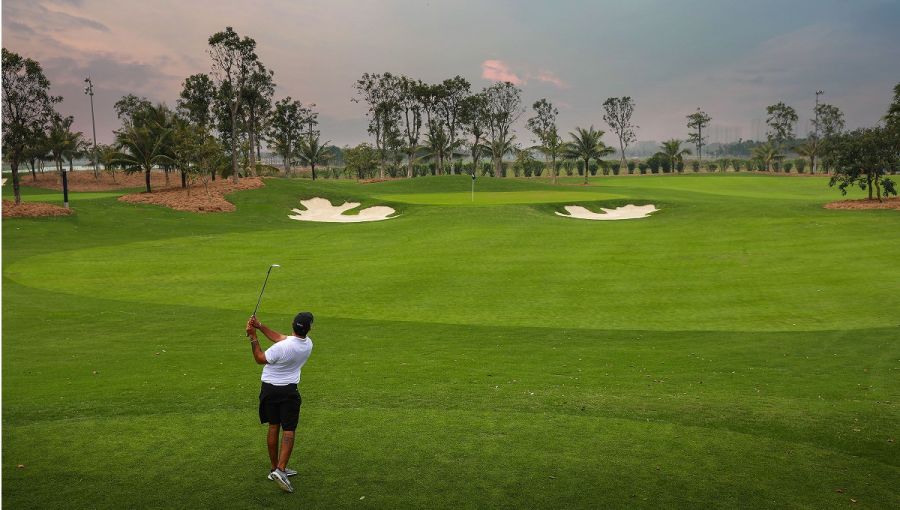
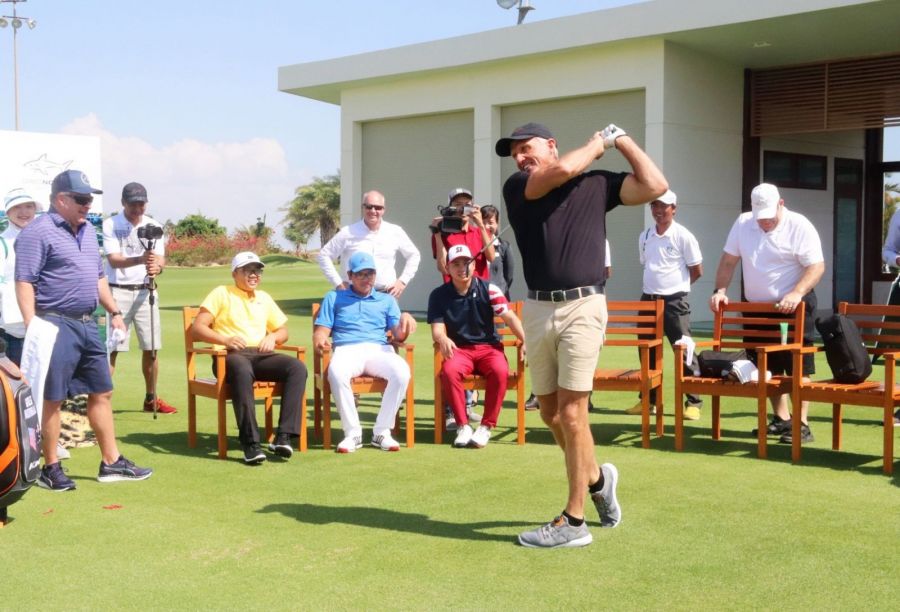

.png)
